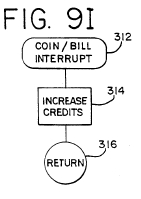
A single patent can have multiple ‘exclusive licensees’ where each licensee has exclusive rights to a portion of the patent rights. Rights are often divided temporally, physically, by field of use, and by type of use. Here, Gamco received an exclusive license grant from gaming giant IGT to sell state authorized NY lottery games covered by the ‘035 patent.
On appeal, the CAFC found that Gamco does not have standing to file suit without the cooperation of the patentee, IGT.
An exclusive licensee possesses standing to sue in its own name if it holds “all substantial rights” to the asserted patent. Historic cases have held that an exclusive territorial licensee has standing without joining the assignee. Here, the court drew a line at exclusive field of use licenses — holding that an exclusive license to a portion of the patented subject matter does not include sufficient rights to create licensee standing. Relying on the Supreme Court’s 1892 Pope v. Jeffery opinion, the appellate panel found that field of use divisions create a real potential that a defendant could face suits from multiple licensees.
“In Pope, as in this case, the license only conveyed rights to a subset of the patented subject matter. For that reason, as in this case, the conveyance posed a threat of multiple suits based on the same allegations of infringement. This court therefore holds that Gamco lacks standing to sue in its own name without joining IGT.”
Senior Judge Friedman gave a different reading to Pope and filed a dubitante opinion — doubting the correctness of the decision.
This screws up a huge number of license agreements – some for millions of dollars. Thanks you Fed Cir! Why change now? This ruling makes little sense in an area of jurisprudence thought settled.
Nobody – Thanks for the clarification. Therefore, this decision is only about when an exclusive licensee needs to compel the patent owner to join the suit. Maybe one reason why there are so few posts on that topic as expressed by Patent leather.
Interesting how with the new rules looming on the horizon, it seems (based on the number of posts here) that nobody cares about unrelated matters right now.
It seems to strain the definition of “exclusive” to narrowly define a field of use and say the licensee is “exclusive” within that field.
Where I come from (Dictionary Land) we call that a non-exclusive license
EU – Actually, a holder of an exclusive license in a field of use may be able to compel the joinder of the patent holder. “a patent owner should be joined, either voluntarily or involuntarily, in any patent infringement suit brought by an exclusive licensee having fewer than all substantial patent rights.” Prima Tek II, 222 F.3d at 1377; Abbott Labs, 47 F.3d at 1131; Evident, 399 F.3d at 1314; Fieldturf, 357 F.3d at 1268; Intellectual Property Development, 248 F.3d at 1348; Mentor H/S, 240 F.3d 1016; Ortho Pharmaceutical, 52 F.3d at 1030; Textile Productions, 134 F.3d at 1484.
Judge Friedman didn’t dissent. He only doubted.
This looks like a disincentive for such “exclusive” licenses. Although the licensee is sure that the patentee will not give the same right in the same field to another party, it is not guaranteed for this licensee that he will be able to prevent unauthorized third parties from practicing the claimed invention in the same field he is licensed for (if the patentee does not want to enforce its patent).
In most occasions where field-limited licenses are granted, it is because the patentee wants to secure many licenses on its patent. The problem then is that he may not want to expose his patent to any nullity actions by going to court for one of his licensees.
That certainly means that licensees exclusively licensed for a limited field should better have an obligation in their license agreement that the patentee shall defend them before courts, even though he may loose its patent, and all its licensees. Otherwise, there is certainly no need for the licensee to pay the price of an exclusive license.
This rationale could apply to related patents, too. For example, assume a parent patent has only apparatus claims, and the child has only counterpart method claims. If the parent patent is subject to an exclusive assignment (or even if it were wholly assigned), it seems under the CAFC’s rationale that the owner of the child patent would be a necessary party to enforcing the parent.
I also disagree with the rationale that exclusivity in territory is adequate to protect against multiplicity of suits. The rationale made sense in 1892 when the Supreme Court decided Pope. 115 years later our country has gotten a lot smaller.
Comments are closed.